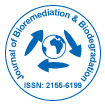Eco-toxicological studies of effluent of a Chlor-alkali industry on growth and photosynthetic efficiency of a cyanobacterium and possible use of this alga in reclamation of effluent waste
Received Date: Dec 22, 2023 / Published Date: Feb 24, 2025
Abstract
All forms of mercury are toxic to plant and animal life. Its use in Chlor-alkali industry as an electrolyte, its discharge into the environment along with effluent and solid waste collected from the effluent canal and dumped near water bodies is alarming. The effluent and solid waste contained significant amount of mercury. Plants around the effluent canal, effluent soaking pond and solid waste dumping site absorbed and accumulated mercury significantly. The experimental alga absorbed and accumulated significant amount of mercury by biosorption and removed significant quantity of mercury by absorption and adsorption. Mercury in the effluent significantly affected the growth (optical density and dry weight), photosynthetic efficiency (pigments) and productivity (PR, RR, GPP) of exposed alga, Westiellopsis prolifica during exposure. This toxicant, mercury contained effluent showed stimulatory effect at maximum allowable concentration and inhibitory impact at higher concentrations of the mercury contained effluent indicating dual behavior of mercury with the alga. At MAC value, the alga grows well and the toxicant could not affect any of the metabolic processes and removes significant amount of mercury from the mercury contaminated effluent. This alga removed mercury by adsorption of Hg on the outer wall and over gelatinous sheath; by absorption from the surrounding environment and accumulating in the cells. The secondary metabolite extract of 4 economically important medicinal plants did not show any reclamation value. However, this alga can be recommended for phycoremediation of mercury contained wastes.
Keywords: Chlor-alkali industry, Effluent, Mercury, Westiellopsis, Growth, Pigments, Photosynthetic efficiency, Plant extract, Productivity, Phytoremediation
Citation: Prusti, Prabha J, Panigrahi AK (2024) Eco-Toxicological Studies of Effluent of a Chlor-Alkali Industry on Growth and Photosynthetic Efficiency of a Cyanobacterium and Possible Use of This Alga in Reclamation of Effluent Waste. J Bioremediat Biodegrad 16: 658.
Copyright: © 2025 Prusti AK, et al. This is an open-access article distributed under the terms of the Creative Commons Attribution License, which permits unrestricted use, distribution and reproduction in any medium, provided the original author and source are credited.
Select your language of interest to view the total content in your interested language
Share This Article
Recommended Journals
Open Access Journals
Article Usage
- Total views: 1079
- [From(publication date): 0-0 - Dec 20, 2025]
- Breakdown by view type
- HTML page views: 914
- PDF downloads: 165
